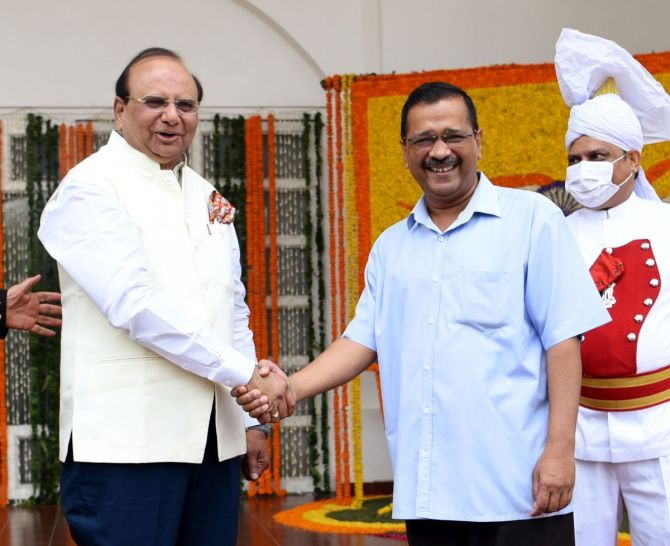- Courses
- GS Full Course 1 Year
- GS Full Course 2 Year
- GS Full Course 3 Year
- GS Full Course Till Selection
- MEP (Mains Enrichment Programme) Data, Facts
- Essay Target – 150+ Marks
- Online Program
- GS Recorded Course
- NCERT- First Ladder
- Polity
- Geography
- Economy
- Ancient, Medieval and Art & Culture AMAC
- Modern India, Post Independence & World History
- Environment
- Governance
- Science & Technology
- International Relations and Internal Security
- Disaster Management
- Ethics
- Current Affairs
- Indian Society and Social Issue
- CSAT
- 5 LAYERED ARJUNA Mentorship
- Public Administration Optional
- ABOUT US
- OUR TOPPERS
- TEST SERIES
- FREE STUDY MATERIAL
- VIDEOS
- CONTACT US
Centre Vs Delhi Tussle over Control on Administrative services
Centre Vs Delhi Tussle over Control on Administrative services

Centre Vs Delhi Tussle over Control on Administrative services
Why in News?
Reccently, a 5-judge Constitution Bench of the Supreme Court (SC) is hearing a dispute between the Delhi government and the Centre over the control of administrative services.
- Almost 5 years ago, another Constitution Bench had ruled in favour of the State government in a similar tussle.
What is the Timeline of the Dispute?
|
2017 Judgement:
|
The Delhi High Court had, in its judgment 2017 held that for administration purposes of the National Capital Territory (NCT), the Lieutenant Governor (L-G) is not bound by the aid and advice of the Council of Ministers in every matter. On appeal, the SC in 2017, referred the matter to decide the interpretation of Article 239AA of the Constitution. |
|
2018 Judgement:
|
A 5-judge Constitution bench had held that the L-G of Delhi is bound by the aid and advice of the elected government, and both needed to work harmoniously with each other. |
|
2019 Judgement:
|
After the split verdict of 2-judge Bench of the SC the matte was referred to 3 -judge bench. Where one judge had ruled the Delhi government has no power at all over administrative services. Another judge, however, had said the transfer or posting of officers in top levels of the bureaucracy (joint director and above) can only be done by the Central government. Also, in case of a difference of opinion for matters relating to other bureaucrats, the view of L-G would prevail. |
|
2022 Case:
|
The Centre on 27th April 2022, went to a larger bench arguing that it needed the power to make transfers and postings of officers in Delhi, as Delhi is the “face of nation”. The court agreed that the limited question relating to the scope of the legislative and executive powers of the Centre and NCT of Delhi, with respect to the term “services”, would need an authoritative pronouncement by a Constitution Bench in terms of Article 145(3) of the Constitution. |
What are the Arguments and Counterarguments in the Issue?
|
Arguments For: |
Counter-Arguments: |
|
The Centre has consistently maintained its point, because Delhi is the national capital and the face of the country, it must have control over administrative services, which include appointments and transfers.
|
The Delhi government has argued that in the interest of federalism, the elected representatives must have power over transfers and postings. Also, Delhi government also said that the Government of National Capital Territory of Delhi (Amendment) Act, 2021, violate the doctrine of basic structure of the Constitution.
|
What is the Governance Model of New Delhi?
- The status of Delhi being a Union Territory under Schedule 1 of the Constitution and ‘National Capital Territory’ under Article 239AA.
- The 69th amendment to the Constitution of India inserted Article 239AA, declared the Union Territory of Delhi to be administered by a L-G, who works on aid and advice of the elected legislative assembly.
- However, the ‘aid and advice’ clause pertains only to matters on which the elected Assembly has powers under the State and Concurrent Lists with the exception of public order, police, and land.
- Further, the Article 239AA also notes that L-G has to either act on the aid and advice of the Council of Ministers, or he is bound to implement the decision taken by the President on a reference being made by him.
- Also, Article 239AA, empowers the L-G to refer a difference of opinion on ‘any matter’ with the Council of Ministers to the President.
- Thus, this dual control between L-G and the elected government leads to a power tussle.
Way Forward:
Extreme political centralisation or chaotic political decentralisation can both lead to the weakening of Indian federalism. The satisfactory and lasting solution of the problem is to be found by striking a balance and decide whether the centre or Delhi government should have control over services in Delhi.
Additional Information:
What is the Constitutional Bench of the Supreme Court?
- A Constitution Bench is a bench of the Supreme Court having five or more judges on it.
- These benches are not a routine phenomenon.
- A vast majority of cases before the Supreme Court are heard and decided by a bench of two judges (called a Division Bench), and sometimes of three.
- The scenarios in which a Constitution Bench can be constituted are:
- If two or three-judge Benches of the Supreme Court have delivered conflicting judgments on the same point of law
- If a later three-judge Bench of the SC doubts the correctness of a judgment delivered by a former Bench with as much strength and decides to refer the matter to a larger bench for reconsideration of the previous judgment.
Constitutional Provisions related to constitutional bench:
- Article 143: When the President seeks the Supreme Court’s opinion under law under Article 143 of the Constitution. However, such advice by the apex court is not binding on the President, nor is it ‘law declared by the Supreme Court’.
- Article 145(3): Article 145(3) provides, “The minimum number of Judges who are to sit for the purpose of deciding any case involving a substantial question of law as to the interpretation of this Constitution or for the purpose of hearing any reference under Article 143 shall be five.”
Must Check: Best IAS Coaching Institute In Delhi
India’s EV Mission: Progress Delayed, Not Denied


